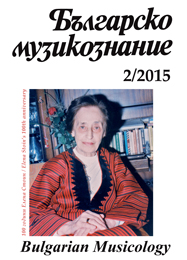Танцуването по български като съвременно пътуване към себе си и света: опит за систематизация на феномена
“Dancing the Bulgarian way” as a form of traveling towards oneself and the world at large: An attempt to systematize the phenomenon
Author(s): Gergana Panova-TekatSubject(s): Anthropology, Theatre, Dance, Performing Arts, Cultural history, Customs / Folklore, Music, Ethnohistory, Local History / Microhistory
Published by: Институт за изследване на изкуствата, Българска академия на науките
Keywords: dancing the Bulgarian way; semantic star; Soviet; American; democratic and emigrant models;
Summary/Abstract: The text analyses the proliferation of the Bulgarian traditional dances in the towns of Bulgaria and the Western World starting from the since 1950s. The author of the text compares dancing with the mode of communication of an infant and examines the individual or group dancing within the framework of a universal three dimensional “semantic star”, whose axes balance between continuity and innovation, individualism and collectivism, body and spirit. On a macro-political level the phenomenon of “dancing the Bulgarian way” varies between four models, which the author has identified in the course of a long-term empirical practice. Every one of the models represents a different way of viewing the world and finding out or proving to oneself, i.e. different semantic stars. The Soviet model was created, financed and rationalized within the context of Socialist Bulgaria. In it one can discern the emergence of not only a new genre of scenic professional art form – the „Bulgarian Folk Choreography”, but a new musical-dance national identity of the Bulgarian people. The American model was created on the other side of the Iron curtain. It represents an active hobby for modern and open minded foreigners, a source of information and more often than not – a source of love for Bulgaria. Of particular interest are the old “authentic” forms of the Bulgarian circle dance, which are thought and practiced regularly in private clubs and big camps. Gradually after 1989 the Bulgarians came up with two additional hybrid models of “dancing the Bulgarian way”. The Democratic model marks the accession of Bulgaria into the European Union and presents the resurgence of the national self- consciousness of the Bulgarian and a boom in the club dance form. The initiative comes from professionals of the Socialist model, who search for and teach traditional dance material. In the West we are witnessing a marked resurgence of ethnicity amongst the younger Bulgarian dancing diaspora. The emigrant model organizes amazing “Bulgarian festivals” and strives through the attractiveness of the Bulgarian stage folk dances to gain respect and equal status outside the borders of their homeland. The conditional differences and similarities uncovered in the process of systematization of the empirical material demonstrate the poly-valence and flexibility of the Bulgarian dance heritage on the crossroad between East and West, Socialism and Capitalism, locality and globalism. At the same time we reach some very general conclusions regarding the role of dancing in the human existence or way of life.
Journal: Българско музикознание
- Issue Year: 2015
- Issue No: 2
- Page Range: 65-82
- Page Count: 18
- Language: Bulgarian
- Content File-PDF

